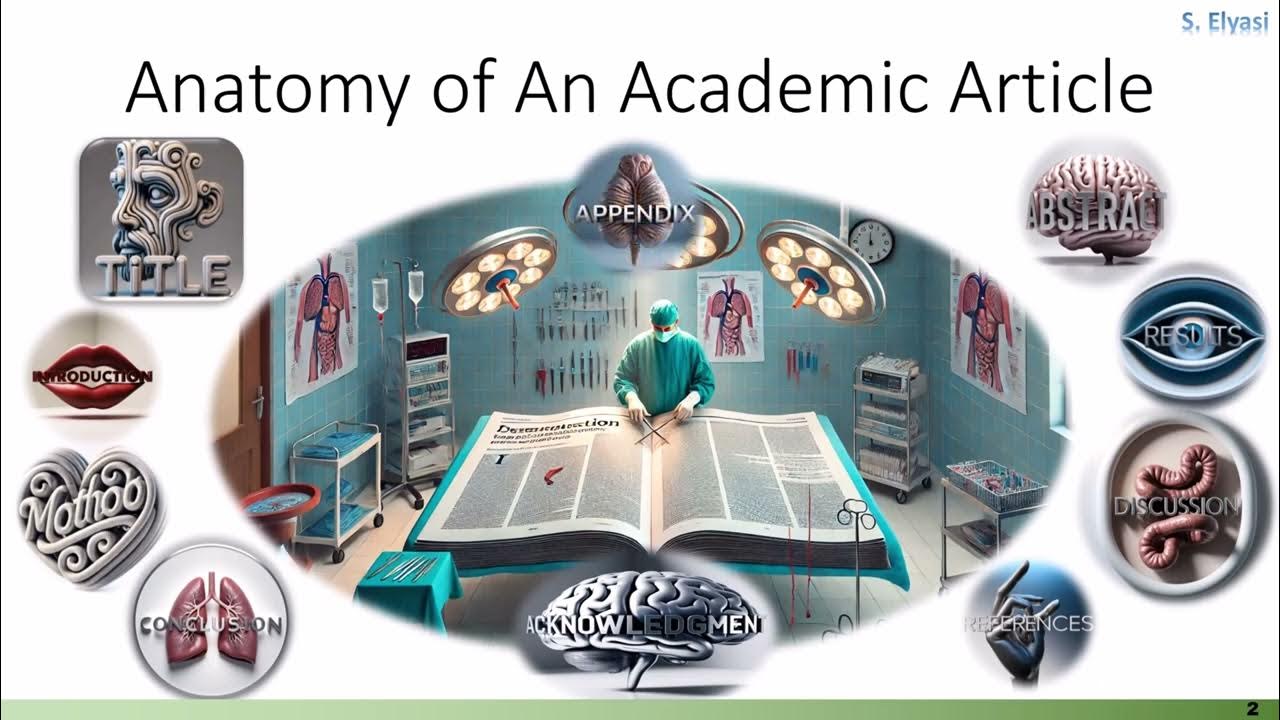Artigo Científico: Entendendo a estrutura. Papo Científico | Anatomia e etc
Summary
TLDRThis educational video script outlines the structure of a scientific article, guiding viewers through sections like the title, authors, abstract, introduction, methodology, results, discussion, and conclusion. It emphasizes the importance of understanding each part, from the significance of a p-value in results to the role of references. Aimed at enhancing comprehension of scientific literature, the script encourages engagement with scientific research.
Takeaways
- 🔍 Scientific articles are structured in a standard way to facilitate understanding and navigation.
- 📝 The title of a scientific article often conveys the most important finding or the main objective of the work.
- 👤 Authors are listed after the title, with numbers linking to their affiliations which are detailed elsewhere in the article.
- 📑 The abstract summarizes the entire work, highlighting the main points, objectives, results, and conclusion.
- 📘 Introductions set the stage for the main subject of the article, providing context and objectives.
- 🔬 The 'Materials and Methods' or 'Methodology' section details the techniques, materials, and procedures used in the research.
- 📊 'Results' section presents the findings, often accompanied by graphs and tables, and includes statistical analysis to determine relevance.
- ✅ A 'p-value' less than 0.05 indicates a statistically significant result, a key concept in scientific research.
- 🔍 The 'Discussion' interprets the results in light of existing literature and provides theoretical explanations for the findings.
- 🔚 'Conclusion' offers the author's opinion on the main findings and often suggests directions for future research.
- 📚 'References' lists all sources cited in the article, formatted according to the journal's style.
Q & A
What is the primary purpose of a scientific article's title?
-The title of a scientific article typically conveys the most important finding or the main objective of the work, aiming to capture the reader's attention and encourage them to continue reading the article.
Why are authors and their affiliations important in a scientific article?
-Authors and their affiliations are crucial as they provide credibility to the research and allow readers to understand the context and institution backing the study. They are linked with numbers that correspond to their institutions, which are detailed elsewhere in the article.
What does the abstract of a scientific article summarize?
-The abstract summarizes the entire work, highlighting the main points of the objectives, results, and conclusion. It serves as a quick overview for readers to determine if the article is of interest and worth reading in full.
What is the role of the introduction section in a scientific article?
-The introduction section introduces the main topic of the article in a way that allows the reader to understand the context and sets the stage for the rest of the article. It also includes the rationale for conducting the study and the objectives of the research.
Why is the methodology section crucial in a scientific article?
-The methodology section is crucial as it details the techniques, materials, equipment, and procedures used in the research. This information is essential for understanding the research process and for other researchers to potentially replicate the study.
What does the results section of a scientific article contain?
-The results section presents the findings from the research, often including graphs and tables. It also includes the statistical analysis of the work, which is used to determine the relevance of the results.
What does a 'p-value' signify in the context of scientific research?
-In scientific research, a 'p-value' less than 0.05 indicates that a result is statistically significant, meaning that the observed difference or effect is unlikely to have occurred by chance alone.
How do symbols like asterisks in scientific articles typically function?
-Symbols like asterisks are often used to denote statistical significance, indicating that there was a difference when comparing two groups in a specific analysis.
What is the purpose of the discussion section in a scientific article?
-The discussion section is where authors interpret the results, comparing them with existing literature and theoretical foundations. It aims to explain why the results were obtained and places them in the context of the broader scientific discourse.
Why are limitations important to mention in a scientific article?
-Mentioning limitations in a scientific article is important for transparency and to provide a balanced view of the research. It acknowledges the constraints of the study and can guide future research to address these limitations.
What can readers expect to find in the conclusion of a scientific article?
-The conclusion of a scientific article typically summarizes the main findings and the author's opinion on the significance of the results. It often includes suggestions for future research.
Why are references important at the end of a scientific article?
-References are important as they provide a list of all the sources cited in the article, allowing readers to trace the origins of the information and ideas presented, and to verify the claims made by the authors.
Outlines

Dieser Bereich ist nur für Premium-Benutzer verfügbar. Bitte führen Sie ein Upgrade durch, um auf diesen Abschnitt zuzugreifen.
Upgrade durchführenMindmap

Dieser Bereich ist nur für Premium-Benutzer verfügbar. Bitte führen Sie ein Upgrade durch, um auf diesen Abschnitt zuzugreifen.
Upgrade durchführenKeywords

Dieser Bereich ist nur für Premium-Benutzer verfügbar. Bitte führen Sie ein Upgrade durch, um auf diesen Abschnitt zuzugreifen.
Upgrade durchführenHighlights

Dieser Bereich ist nur für Premium-Benutzer verfügbar. Bitte führen Sie ein Upgrade durch, um auf diesen Abschnitt zuzugreifen.
Upgrade durchführenTranscripts

Dieser Bereich ist nur für Premium-Benutzer verfügbar. Bitte führen Sie ein Upgrade durch, um auf diesen Abschnitt zuzugreifen.
Upgrade durchführenWeitere ähnliche Videos ansehen
5.0 / 5 (0 votes)






